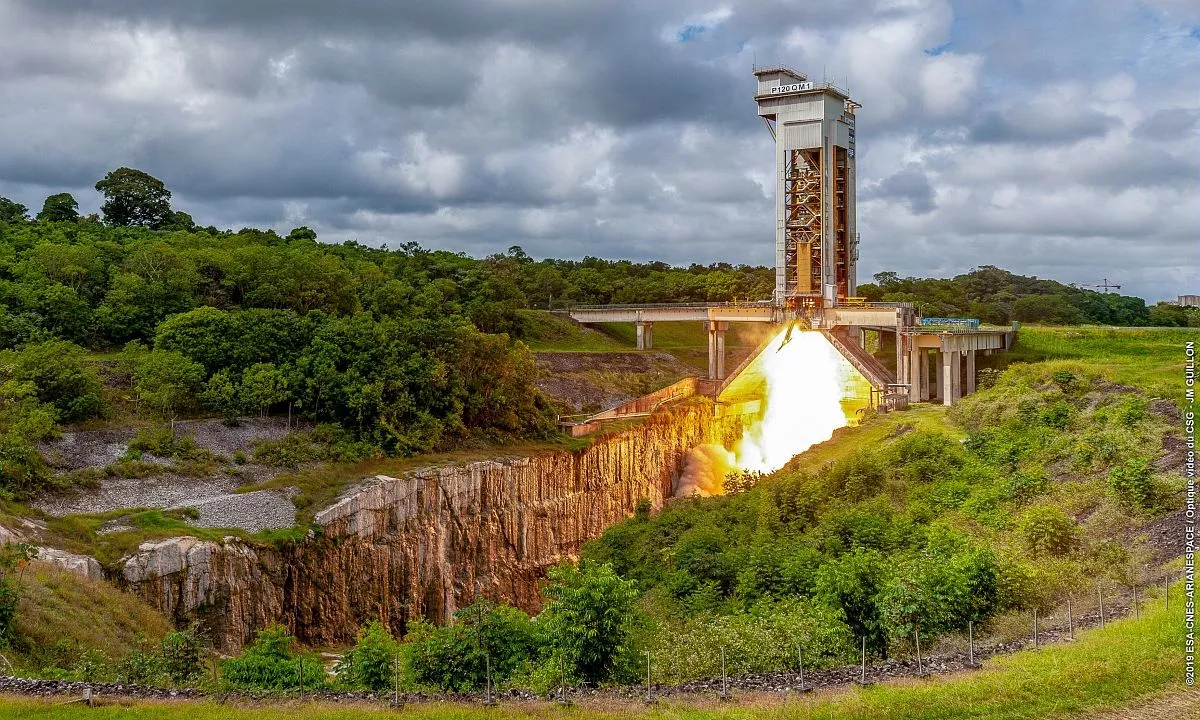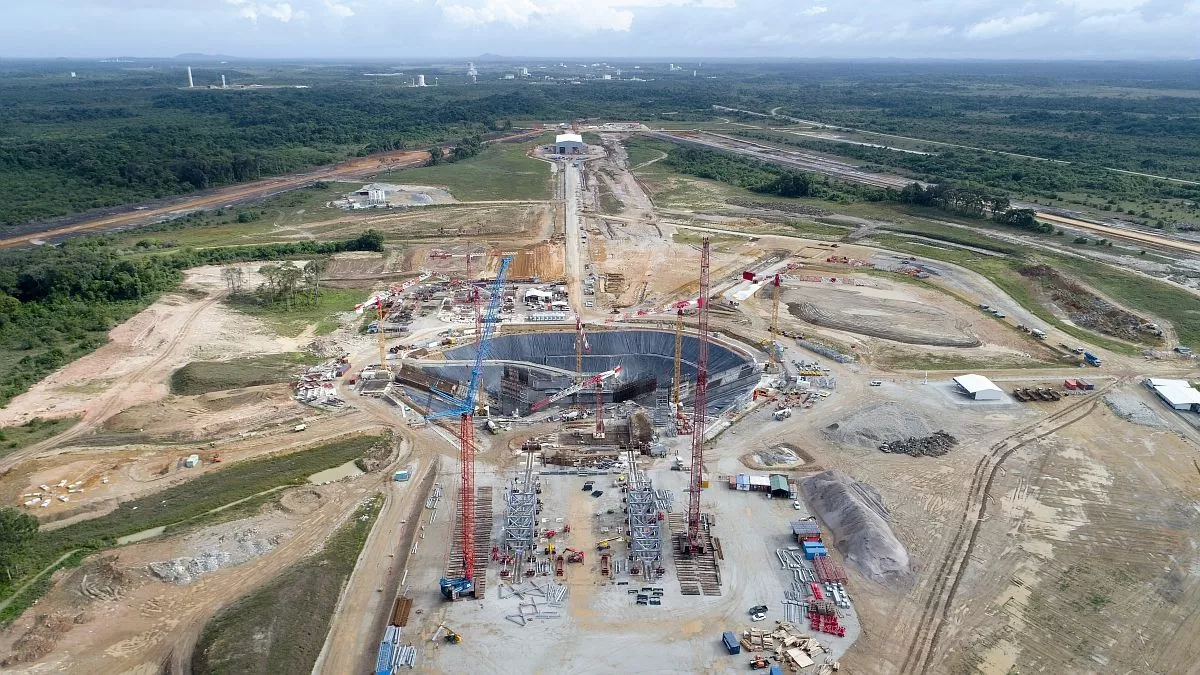Studying the impacts
To protect the environment on and around the Europe's spaceport, CNES implements a policy of environmental risk prevention and ensures continuous monitoring of the impacts of its activities (launches, preparations for launchers and satellites, construction sites).
Launches
To measure the impact of launches an Environmental Measurement Plan (EMP) is rolled out for each launch.
The EMP measures the impact of space activity on receiving environments (water, sediment, biodiversity). It is composed of physico-chemical measurements carried out for each launch as well as bio-monitoring measures throughout the year.
The results are available on this page.
A - The impact of a launcher on the environment
In both the Ariane and Vega launchers, the products of combustion are mainly hydrochloric gas, alumina, carbon monoxide and carbon dioxide.
They are emitted over the first 10 kilometres after lift-off. This corresponds to about 1 minute of flight. Their concentration is significant only within a perimeter of 1 km around the launch zone.
Effects on the natural environment:
Hydrochloric gas (HCl) may present a risk of slightly acid rain at CSG, with a negligible impact on flora, fauna, infrastructure, etc.
Alumina (Al2O3) is a non-toxic product due to its chemical nature (inert particles). As it is highly diluted in the atmosphere, alumina, in its dust form, cannot have any effect on health. Note: French Guiana's soil is rich in alumina (as evidenced by the presence of bauxite deposits), and natural alumina concentrations are not altered by ground fallout during launches.
The fallback of stages into the sea
The normal course of a flight from the CSG involves the stages of the launcher falling into the sea once they have completed their mission. Their metal casings are designed to break apart on impact with the water and sink, leaving no floating debris. Their contents, powder or fuel, having been consumed, no longer contain any harmful substances.
B - The measurement system
The EMP provides for more than 100 measurement points at each launch, representing around 600 samples. Numerous parameters are monitored around the launch pad and throughout the space base, as well as in Kourou and Sinnamary:
- Air quality measurements: monitoring of hydrochloric gas and alumina fallout, using fixed and mobile air analysers and water tanks. Monitoring of satellite fuel fallout (in the event of a launch vehicle accident). Biomonitoring with bees.
- Measurement of water quality in Karouabo Creek, Malmanoury Creek and Macouria Creek, with monitoring of surface and groundwater.
- Analysis of sediment quality.
- Vegetation monitoring: analysis of rainwater taken from under the plant cover.
- Monitoring of aquatic fauna and flora (using an index specific to French Guiana).
Vibration and acoustic measurements are also carried out for certain launches, at CSG as well as in Sinnamary (Hôtel du Fleuve) and Kourou (Hôtel des Roches).
C - In the event of an launcher accident
In the event of an explosion involving the launcher, the fallout is mainly made up of :
- unburnt fuels (launcher + satellites): hydrazine and derivatives,
- unburnt oxidants (launcher + satellites): nitrogen oxides and derivatives,
- propellant,
- launcher and satellite debris.
Effects near the launch pad
Impacts on the environment remain localised around the launch zone.
The effects of hydrochloric gas, alumina, hydrazine products and nitrogen oxides may be observed on :
- the quality of the surrounding air
- the terrestrial environment (fauna, flora, etc.).
Effects over the Atlantic Ocean
- The explosion of the launcher in flight results in the dispersion of chemical fallout, which has a direct impact on the quality of the surrounding air.
- It should be noted that when the launcher is neutralised, the satellite tanks fall intact into the sea. It is on impact with the ocean that the satellite propellants are released. The effects will be temporary, localised degradation of water quality (products that are not very persistent) and the formation of a toxic cloud (effects on air quality) that moves with the wind.
- As this cloud progresses, it disperses in the atmosphere, causing a reduction in the levels of toxic elements. This phenomenon causes the cloud to lose its hazardous nature (toxic product levels below regulatory thresholds). If the cloud reaches the Guiana coast (Kourou or Sinnamary), the impact on coastal flora and fauna will be negligible due to this dilution effect.
At each launch, a crisis unit is set up, ready to intervene in the event of an accident to ensure the protection of people, property and the environment. To find out more, click here.
D - EMP reports
The results of the Environmental Measurement Plan for each flight are summarized in reports sent to the Direction Générale des Territoires et de la Mer (DGTM), various scientific bodies, the town halls of Kourou and Sinnamary, and the SPPPI (Secrétariat Permanent pour la Prévention des Pollutions Industrielles).
They are also available to the public on this page as soon as they are published.
Find out more about the results already published below: the annual reviews of the EMPs from 2012 to 2023, as well as the detailed results of the EMP for the first launch in 2024, VA262.
2023 Assessment 2022 Assessment 2021 Assessment
2020 Assessment 2019 Assessment 2018 Assessment
2017 Assessment 2016 Assessment 2015 Assessment
2014 Assessment 2013 Assessment 2012 Assessment
For older assessments, please contact us : csg-accueil[at]cnes.fr
Preparation activities
CNES is subject to the regulations governing classified facilities, which aim to protect the environment from the risks associated with combustion facilities, service stations, satellite preparation facilities, the test bench for solid propellant boosters and the propellant destruction area. Accordingly, those activities at Europe’s Spaceport must be declared and authorized under the terms of prefectural decrees.

Testing a booster on the test bench for solid propellant boosters.
Infrastructure projects and construction sites
Infrastructure projects necessary for the development of activities of Europe's Spaceport such as photovoltaic fields or launch facilities for micro-launchers are subject to administrative files including, among other things, an impact study taking into account wildlife, Flora, aquatic environments, air quality, soils and subsoil …Following the studies and administrative procedures required (building permit, unique environmental authorization…), the projects are carried out in full respect of requirements set forth by the Prefecture. Measures to reduce and/or compensate for impacts may also be imposed during the construction or operation of installations.

Construction of the Ariane 6 launch pad in 2018.